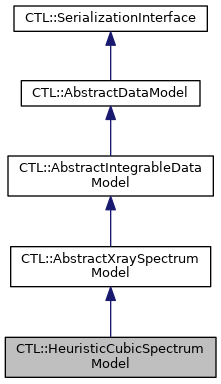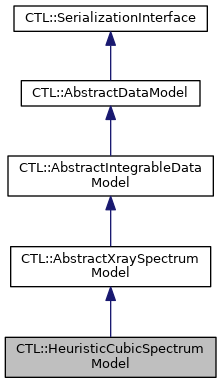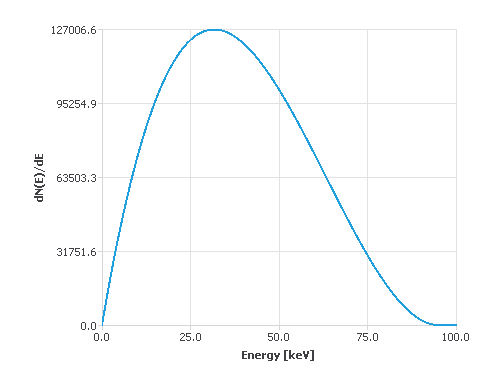The HeuristicCubicSpectrumModel class is a data model to represent an (heuristic) X-ray spectrum with respect to a simple degree-three polynomial. More...
#include <xrayspectrummodels.h>


Public Types | |
| enum | { Type = 42 } |
 Public Types inherited from CTL::AbstractDataModel Public Types inherited from CTL::AbstractDataModel | |
| enum | { Type = 0 } |
 Public Types inherited from CTL::SerializationInterface Public Types inherited from CTL::SerializationInterface | |
| enum | { Type = -1, UserType = 65536 } |
Public Member Functions | |
| int | type () const override |
| float | valueAt (float position) const override |
| Returns the value (i.e. photon count per energy) of the model at the given position (in keV). More... | |
| float | binIntegral (float position, float binWidth) const override |
| Returns the integral over model values (i.e. total number of photons) in the (energy) interval [position - 0.5 * binWidth, position + 0.5 * binWidth]. More... | |
| HeuristicCubicSpectrumModel * | clone () const override |
 Public Member Functions inherited from CTL::AbstractXraySpectrumModel Public Member Functions inherited from CTL::AbstractXraySpectrumModel | |
| void | setParameter (const QVariant ¶meter) override |
| Sets the energy parameter to parameter. More... | |
| QVariant | parameter () const override |
 Public Member Functions inherited from CTL::AbstractIntegrableDataModel Public Member Functions inherited from CTL::AbstractIntegrableDataModel | |
| float | meanValue (float position, float binWidth) const |
 Public Member Functions inherited from CTL::AbstractDataModel Public Member Functions inherited from CTL::AbstractDataModel | |
| void | fromVariant (const QVariant &variant) override |
| QVariant | toVariant () const override |
| bool | isIntegrable () const |
| void | setName (const QString &name) |
| const QString & | name () const |
 Public Member Functions inherited from CTL::SerializationInterface Public Member Functions inherited from CTL::SerializationInterface | |
| virtual | ~SerializationInterface ()=default |
Friends | |
| template<class > | |
| struct | SerializationHelper::RegisterWithSerializationHelper |
Additional Inherited Members | |
 Protected Member Functions inherited from CTL::AbstractIntegrableDataModel Protected Member Functions inherited from CTL::AbstractIntegrableDataModel | |
| AbstractIntegrableDataModel (const AbstractIntegrableDataModel &)=default | |
| AbstractIntegrableDataModel (AbstractIntegrableDataModel &&)=default | |
| AbstractIntegrableDataModel & | operator= (const AbstractIntegrableDataModel &)=default |
| AbstractIntegrableDataModel & | operator= (AbstractIntegrableDataModel &&)=default |
 Protected Member Functions inherited from CTL::AbstractDataModel Protected Member Functions inherited from CTL::AbstractDataModel | |
| AbstractDataModel (const AbstractDataModel &)=default | |
| AbstractDataModel (AbstractDataModel &&)=default | |
| AbstractDataModel & | operator= (const AbstractDataModel &)=default |
| AbstractDataModel & | operator= (AbstractDataModel &&)=default |
 Protected Member Functions inherited from CTL::SerializationInterface Protected Member Functions inherited from CTL::SerializationInterface | |
| SerializationInterface ()=default | |
| SerializationInterface (const SerializationInterface &)=default | |
| SerializationInterface (SerializationInterface &&)=default | |
| SerializationInterface & | operator= (const SerializationInterface &)=default |
| SerializationInterface & | operator= (SerializationInterface &&)=default |
 Protected Attributes inherited from CTL::AbstractXraySpectrumModel Protected Attributes inherited from CTL::AbstractXraySpectrumModel | |
| float | _energy = 0.0f |
| Control parameter of device setting (usually tube voltage). | |
 Related Functions inherited from CTL::AbstractDataModel Related Functions inherited from CTL::AbstractDataModel | |
| DataModelPtr | |
| Template alias name for CopyableUniquePtr<ModelType> to a suitable ModelType. | |
| AbstractDataModelPtr | |
| Alias name for DataModelPtr<AbstractDataModel>. More... | |
| std::unique_ptr< ModelType > | makeDataModel (ConstructorArguments &&... arguments) |
| using DataModelPtr | CopyableUniquePtr |
| Alias name for CopyableUniquePtr<ModelType> to a suitable ModelType. | |
Detailed Description
The HeuristicCubicSpectrumModel class is a data model to represent an (heuristic) X-ray spectrum with respect to a simple degree-three polynomial.
This class uses a simple cubic polynomial to (roughly) approximate the shape of a real X-ray spectrum. Different from KramersLawSpectrumModel, this also includes the effect that the number of emitted photons drops towards low energies.
For details on the model, see valueAt() and binIntegral().
Example:

Member Function Documentation
◆ binIntegral()
|
overridevirtual |
Returns the integral over model values (i.e. total number of photons) in the (energy) interval [position - 0.5 * binWidth, position + 0.5 * binWidth].
Let \( E_{max} \) be the currently set energy parameter of this instance and \( [E_0, E_1] \) the borders of the bin as specified by position and binWidth, then the bin integral can be expressed as follows:
\( \begin{align*} N &= \int_{E_0^{*}}^{E_1^{*}} \frac{dN(E)}{dE} \,dE = \left[ -\frac{1}{3}E_{max} (E_{max} - E)^3 +\frac{1}{4} (E_{max} - E)^4 \right]_{E_0^{*}}^{E_1^{*}} \end{align*} \)
Note that \( E_0^{*} \) and \( E_1^{*} \) are modified boundaries as follows:
\( \begin{align*} E_0^{*} &= \max(E_0, 0) \\ E_1^{*} &= \min(E_1, E_{max}) \end{align*} \)
Note that the scaling factor of these values is arbitrary and in practical cases (e.g. when used in source components of the CTL) the number of photons scales with the irradiated area, the distance from the source and typically another proportionality describing the output power (e.g. tube current).
Implements CTL::AbstractIntegrableDataModel.
◆ clone()
|
overridevirtual |
Creates a copy of this instance and returns a base class pointer to the new object.
Implements CTL::AbstractXraySpectrumModel.
◆ type()
|
inlineoverridevirtual |
Returns the type id of this instance.
Reimplemented from CTL::AbstractDataModel.
◆ valueAt()
|
overridevirtual |
Returns the value (i.e. photon count per energy) of the model at the given position (in keV).
Let \( E_{max} \) be the currently set energy parameter of this instance and \( E \) the requested sampling point (i.e. position), then the underlying function for this model is given by: \( \frac{dN(E)}{dE}= \begin{cases} E_{max} * (E_{max} - E)^2 - (E_{max}- E)^3 & E < E_{max} \\ 0 & E \geq E_{max} \end{cases} \)
Note that the scaling factor of these values is arbitrary and in practical cases (e.g. when used in source components of the CTL) the number of photons scales with the irradiated area, the distance from the source and typically another proportionality describing the output power (e.g. tube current).
Implements CTL::AbstractDataModel.
The documentation for this class was generated from the following files:
- modules/src/models/xrayspectrummodels.h
- modules/src/models/xrayspectrummodels.cpp
 1.8.16
1.8.16